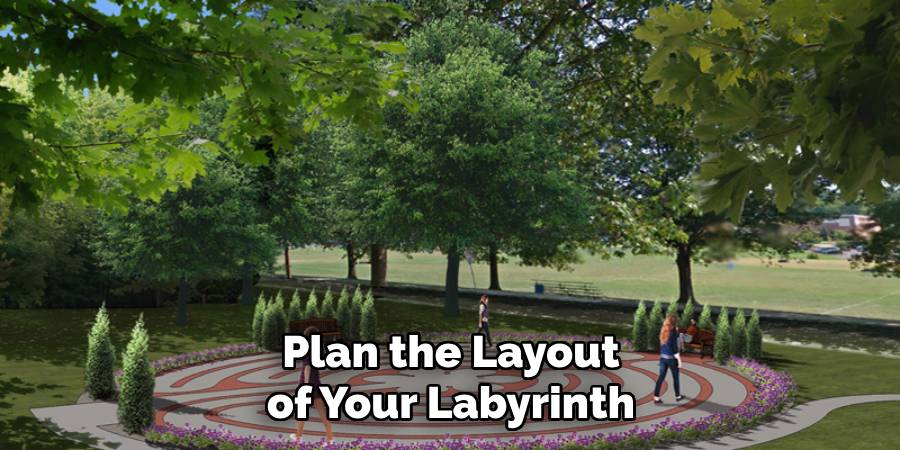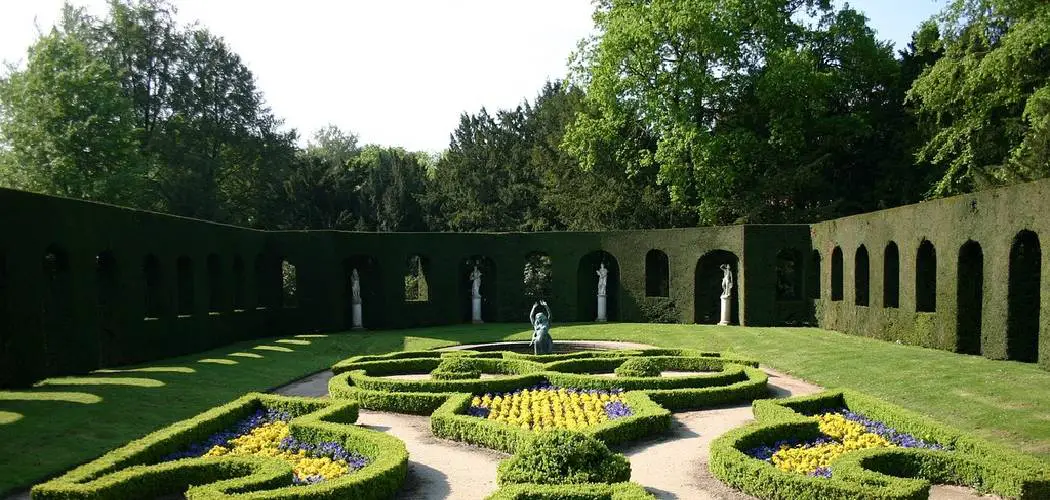
Do you want to create a magical space in your garden that takes guests on a journey of discovery and harkens back to the ancient art of labyrinth creation? With some creativity, planning, and dedication, it’s possible to transform any outdoor area into a unique labyrinth.
In this blog post, we’ll look at how to create a labyrinth in your garden. From selecting colors and patterns to deciding which plants and features best complement the landscape — there are plenty of factors to consider! Be sure to follow along as we explore everything from ground measurements right up until installation day – let’s get started!
Tools and Materials You Will Need to Create a Labyrinth in Your Garden
- Measuring tape
- String or rope
- Stakes
- Garden hose (optional)
- Landscaping paint or chalk
- Shovel and/or gardening tools
- Plants, flowers, and other garden features
Step-by-step Guidelines on How to Create a Labyrinth in Your Garden
Step 1: Choosing the Right Location for Your Labyrinth
The first step in creating a labyrinth is choosing the best location for it in your garden. Consider the size and shape of your garden, as well as any existing landscaping features or structures that may impact the labyrinth’s design. It’s also important to keep in mind that labyrinths are typically meant to be walked through, so choose a spot with enough open space for people to comfortably navigate.
Step 2: Measuring and Marking Out Your Labyrinth

Once you’ve chosen the location, use your measuring tape to determine the dimensions and shape of your labyrinth. If you’re creating a circular or oval-shaped labyrinth, you can use a string or rope tied to stakes to mark out the perimeter. Alternatively, using a garden hose is another great option for easily forming curved lines.
For more complex patterns, consider using landscaping paint or chalk to map out the design before digging.
Step 3: Digging and Shaping Your Labyrinth Path
Using your shovel, carefully dig out the pathway of your labyrinth according to the markings made in step 2. Be sure to remove any grass or other growth from the area to create a clean surface for the path.
Depending on the size and complexity of your labyrinth, you may also want to consider adding raised beds, rocks, or other features along the path to add visual interest and make your garden labyrinth truly unique.
Step 4: Adding Plants and Features
Once the pathway is dug out and shaped, it’s time to add plants and features that will enhance the experience of walking through your labyrinth. Consider using taller plants along the perimeter of the labyrinth to create a sense of enclosure, while adding brightly colored flowers and other decorations throughout the path will add visual interest and keep guests engaged. You can also incorporate other elements such as statues, benches, or water features to add a touch of whimsy and playfulness.
Step 5: Maintenance and Care

As with any garden feature, it’s important to regularly maintain your labyrinth. Keep an eye on plant growth and remove any weeds or unwanted growth from the pathway. You may also want to periodically add new features or adjust the layout to keep things fresh and engaging for visitors. If you live in an area with harsh weather, be sure to take the necessary precautions to protect your labyrinth from damage.
Now that you have all the steps for creating a garden labyrinth, it’s time to put them into action! With some patience and inspiration, you can create a unique and enchanting space in your garden that will leave guests feeling relaxed and inspired. Happy labyrinth!
Additional Tips and Tricks to Create a Labyrinth in Your Garden
- Consider adding elements of surprise and wonder in your labyrinth, such as hidden rooms or secret pathways.
- Use different types of plants to create a diverse and visually appealing labyrinth. You can also incorporate fragrant flowers to stimulate the senses.
- Incorporate natural features like trees, rocks, and water sources into your design to add a sense of harmony with nature.
- Create a focal point or center of the labyrinth, such as a statue or fountain, to draw visitors towards it and create a sense of completion.
- Add benches or seating areas throughout the labyrinth for visitors to rest and take in the surroundings.
- Use lighting elements to enhance the experience at night and allow for evening visits.
- Consider incorporating educational elements into your labyrinth design, such as signage explaining the types of plants or the historical significance of certain features.
- Continuously maintain and trim the plants to ensure the labyrinth stays true to its intended design and remains safe for visitors.
Following these tips and tricks can help you create a captivating and unique labyrinth in your garden. Remember to let your creativity flow and have fun with the design process, as every labyrinth is a reflection of its creator’s imagination and vision. Enjoy the journey through your own personal oasis and watch as your garden transforms into an enchanting destination for all who visit it. Happy labyrinthine!
Things You Should Consider to Create a Labyrinth in Your Garden

1. Consider the theme of your garden and choose a design that compliments it. Labyrinths come in various designs such as circular, square, spiral, or even freeform. Choose a design that fits well with the overall aesthetic of your garden.
2. Decide on the size and location of your labyrinth. The size can vary depending on the space available in your garden, but it is recommended to have at least a 10-foot wide path for comfortable walking. Also, consider the location of your labyrinth to avoid any disturbances or obstacles while walking through it.
3. Choose suitable materials for your labyrinth. You can use natural materials like grass, gravel, stones, or even flowers to create the paths of your labyrinth. Alternatively, you can also use pavers, bricks, or other man-made materials for a more permanent structure.
4. Plan the layout of your labyrinth. It is important to have a clear idea of how you want your labyrinth to flow before starting the construction process. Consider incorporating turns, dead ends, or even hidden spots for added excitement and challenge.
5. Create a focal point in the center of your labyrinth. This could be a sculpture, a water feature, or even a seating area for relaxation. Having a focal point can add visual interest and provide a sense of accomplishment once you reach the center.
6. Keep in mind the maintenance of your labyrinth. Regular pruning and weeding will be necessary to keep your labyrinth looking neat and tidy. Consider using low-maintenance plants or materials if you do not have the time or resources for constant upkeep.
7. Add personal touches to your labyrinth. Consider adding personal objects, decorations, or even dedications along the paths of your labyrinth. This will make it a unique and special experience for you and your guests.
8. Consider incorporating lights or other features for night-time use. Labyrinths can be enjoyed during both day and night with the addition of lights or other features such as fountains or wind chimes. This can add a whole new dimension to your labyrinth experience.
9. Test out the labyrinth before finalizing it. Once you have completed the construction, take some time to walk through the labyrinth and make any necessary adjustments for a smoother flow
Following these considerations will help you create a beautiful and functional labyrinth in your garden that can be enjoyed by all. Remember to have fun with the process and let your creativity guide you as you design your very own garden oasis. Happy Labyrinth building!
Frequently Asked Questions
What is a Labyrinth?

A labyrinth is a maze-like structure consisting of a single, winding path that leads to a center point and then back out again. Unlike traditional mazes, which feature multiple paths and dead ends, labyrinths have only one path that twists and turns but ultimately leads to the destination.
Labyrinths have been around for centuries and can be found in various cultures and religions. They are often used for meditation, reflection, and relaxation.
Why Should I Create a Labyrinth in My Garden?
There are many reasons why you may want to create a labyrinth in your garden. Some people view labyrinths as a form of art or a unique addition to their landscape. Others see them as a way to add an element of adventure or playfulness to their outdoor space.
Labyrinths can also serve as a form of mindfulness or stress relief, providing a peaceful and calming environment for reflection and introspection.
Can I Customize My Labyrinth?
Absolutely! One of the great things about creating a labyrinth in your garden is that you have the freedom to make it your own. You can choose the materials, colors, and patterns that reflect your personal style and preferences.
You can also incorporate elements such as meditation benches or statues to enhance the experience of walking through the labyrinth.
How Do I Maintain My Labyrinth?
Maintaining a labyrinth is relatively simple. Regularly inspect the path for any damage or overgrowth and make necessary repairs. You may also want to add new decorations or plants to keep the space fresh and inviting. Depending on your climate and location, you may need to mow or trim the grass around the labyrinth as well.
Conclusion
With the above outlined you can easily learn how to create a labyrinth in your garden and have a unique and meaningful addition to your outdoor space. Whether it’s for relaxation, mindfulness, or simply aesthetic purposes, a labyrinth can bring joy and tranquility to your garden for years to come. So go ahead, let your creativity flow, and start planning your very own garden labyrinth today!
So why not give it a try and see the difference it can make in your garden?Experiment with different designs, materials, and decorations to make your labyrinth truly one-of-a-kind. And don’t forget to share your experience with others – who knows, you may inspire someone else to create their own garden labyrinth too! Happy labyrinthine!
About
Outdoor Fixes is a distinguished figure in the world of Diy design, with a decade of expertise creating innovative and sustainable Diy solutions.
His professional focus lies in merging traditional craftsmanship with modern manufacturing techniques,
fostering designs that are both practical and environmentally conscious. As the author of diy,
outdoorfixes delves into the art and science of outdoorfixes-making, inspiring artisans and industry professionals alike.
Education RMIT University
(Melbourne, Australia) Associate Degree in Design (Outdoor Fixes) Focus on sustainable design, industry-driven projects,
and practical craftsmanship. Gained hands-on experience with traditional and digital manufacturing tools, such as CAD and CNC software.
Nottingham Trent University
(United Kingdom) Bachelor’s in outdoorfixes.com and Product Design (Honors) Specialized in product design with a focus on blending creativity with production
techniques. Participated in industry projects, working with companies like John Lewis and Vitsoe to gain real-world insights.
Publications and Impact
In diy, Outdoor Fixes his insights on indoor design processes, materials, and strategies for efficient production.
His writing bridges the gap between artisan knowledge and modern industry needs, making it a must-read for both budding designers and seasoned professionals.

